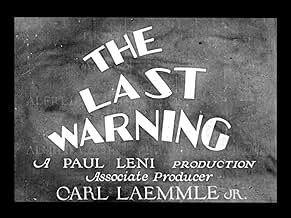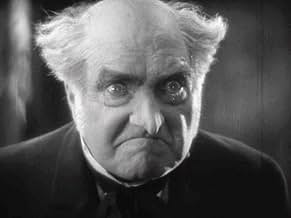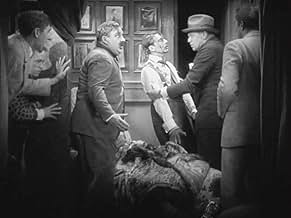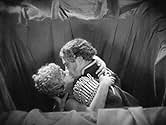अपनी भाषा में प्लॉट जोड़ेंA producer decides to reopen a theater, that had been closed five years previously when one of the actors was murdered during a performance, by staging a production of the same play with the... सभी पढ़ेंA producer decides to reopen a theater, that had been closed five years previously when one of the actors was murdered during a performance, by staging a production of the same play with the remaining members of the original cast.A producer decides to reopen a theater, that had been closed five years previously when one of the actors was murdered during a performance, by staging a production of the same play with the remaining members of the original cast.
Carrie Daumery
- Barbara Morgan
- (as Mme. Carrie Daumery)
Slim Summerville
- Tommy Wall
- (as 'Slim' Summerville)
Bud Phelps
- Sammy
- (as 'Buddy' Phelps)
Charles K. French
- Doctor
- (बिना क्रेडिट के)
Pat Harmon
- Cop
- (बिना क्रेडिट के)
Francisco Marán
- Jeffries
- (बिना क्रेडिट के)
फ़ीचर्ड समीक्षाएं
Last Warning, The (1929)
*** 1/2 (out of 4)
Paul Leni (The Cat and the Canary, The Man Who Laughs) directs this Universal horror film, which has been forgotten over the years but if you've seen some of the studios bigger pictures then you've can tell what all this film has influenced. A popular show on Broadway, inside a creepy theatre, is closed down after the mysterious murder of one of the actors. Years later the police reassemble the original cast and bring them back to the theater to see if they can trap the murderer but it might be a ghost they're dealing with. This film mixes elements of The Phantom of the Opera with the old dark house themes of films like The Bat and delivers a terrific entertainment. This film has never been officially released so I had to view it via what appears to be a 16mm print and the quality was pretty bad throughout so if I get a chance to see a pristine print then I'll probably bump my review up. The technical eye of Leni, who died after this film, is untouched by nearly everyone as he's constantly trying new and different things with the camera. I love how he'll have a medium shot and then move the camera in to show some evidence before moving it back out to let the action role. The film runs just under 80-minutes and goes by very fast with some exciting action but also a great story to work with. The actors, including John Boles who would later appear in Frankenstein, all do nice work as well. There are a few twists and turns along the way that actually work well within the story. This film works on a technical level as well as the story level and that makes this a wonderful little gem that needs to be rediscovered. The only thing people know about this movie nowdays is that it was a huge influence on James Whale and this is easy to see. There's a woman here, used as comic relief, which is later a carbon copy in Una O'Connor. The Old Dark House also lifts some shots here but I won't say which ones since it'll ruin scenes in both movies. The score here was also later reused in Dracula and this film was shot on the same sets as The Phantom of the Opera so there's a lot of connections here.
*** 1/2 (out of 4)
Paul Leni (The Cat and the Canary, The Man Who Laughs) directs this Universal horror film, which has been forgotten over the years but if you've seen some of the studios bigger pictures then you've can tell what all this film has influenced. A popular show on Broadway, inside a creepy theatre, is closed down after the mysterious murder of one of the actors. Years later the police reassemble the original cast and bring them back to the theater to see if they can trap the murderer but it might be a ghost they're dealing with. This film mixes elements of The Phantom of the Opera with the old dark house themes of films like The Bat and delivers a terrific entertainment. This film has never been officially released so I had to view it via what appears to be a 16mm print and the quality was pretty bad throughout so if I get a chance to see a pristine print then I'll probably bump my review up. The technical eye of Leni, who died after this film, is untouched by nearly everyone as he's constantly trying new and different things with the camera. I love how he'll have a medium shot and then move the camera in to show some evidence before moving it back out to let the action role. The film runs just under 80-minutes and goes by very fast with some exciting action but also a great story to work with. The actors, including John Boles who would later appear in Frankenstein, all do nice work as well. There are a few twists and turns along the way that actually work well within the story. This film works on a technical level as well as the story level and that makes this a wonderful little gem that needs to be rediscovered. The only thing people know about this movie nowdays is that it was a huge influence on James Whale and this is easy to see. There's a woman here, used as comic relief, which is later a carbon copy in Una O'Connor. The Old Dark House also lifts some shots here but I won't say which ones since it'll ruin scenes in both movies. The score here was also later reused in Dracula and this film was shot on the same sets as The Phantom of the Opera so there's a lot of connections here.
This movie pops up on ebay once in a while and for fans of mystery or horror films, particularly those of Universal, this is a must.
The plot is unimportant - it is about a haunted old theater where an old Broadway play is being brought back despite threats from the ghost of a dead actor.
This film was the last directed by the great Paul Leni. It is really the work of a virtuoso working at his peak. It has everything The Cat and the Canary had and more. The version that seems to be relatively available on video has a good music track too, but unfortunately it seems that the experimental sound sequences the film originally contained have not survived.
Nevertheless, we are lucky that this film has survived as it is such a joyous romp of horror cliches with inventive, wild camera moves and stunning lighting and spooky set design. It foreshadows the great horror classics that were less than two years away for Universal. It is just wonderful filmmaking from a forgotten great director who was at his peak, so if you are into old dark house mysteries or Universal horror movies - FIND IT! - It is one of the best!
8/10 - even better than The Cat and the Canary.
The plot is unimportant - it is about a haunted old theater where an old Broadway play is being brought back despite threats from the ghost of a dead actor.
This film was the last directed by the great Paul Leni. It is really the work of a virtuoso working at his peak. It has everything The Cat and the Canary had and more. The version that seems to be relatively available on video has a good music track too, but unfortunately it seems that the experimental sound sequences the film originally contained have not survived.
Nevertheless, we are lucky that this film has survived as it is such a joyous romp of horror cliches with inventive, wild camera moves and stunning lighting and spooky set design. It foreshadows the great horror classics that were less than two years away for Universal. It is just wonderful filmmaking from a forgotten great director who was at his peak, so if you are into old dark house mysteries or Universal horror movies - FIND IT! - It is one of the best!
8/10 - even better than The Cat and the Canary.
Paul Leni's last film after which he died from sepsis brought on by an infected tooth (seriously, go to your dentist), this is probably the first film in his Universal contract where he had real freedom after the large series of successes that had preceded it. Smaller in scale than his previous The Man Who Laughs and more than somewhat reminiscent of his first Universal feature, The Cat and the Canary, The Last Warning is a whodunit with a real sense of fun about its mystery and the movements through the plot without ever quite becoming a comedy. It stands on this razor's edge of tone and balances quite nicely, I think. It's not a great film, but it is a solidly fun one.
John Woodford, the actor whose theater shares his name, dies suddenly during a performance of the play The Snare when he grabs an electric lamp and dies instantly. It's a mystery that the police cannot solve, and the theater shuts down that very night for years.
Years later, the Bunce Brothers, Josiah (Burr McIntosh) and Robert (Mack Swain), reopen the theater under the supervision of Arthur McHugh (Montagu Love) who wants to do The Snare again with the same cast. McHugh is actually a police officer doing those sorts of weird, out-there investigations of a cold case that's going to get the culprit to reveal themselves out of guilt. I mean, it's nonsense, but it makes for some good melodramatics.
Anyway, the cast includes leading lady Doris (Laura La Plante), Richard (John Boles), and lothario Carleton (Roy D'Arcy). There's also the electrician Tommy (Slim Summerville) who points at every returning man and whispers that they're the one who killed Woodford, and the stage manager Mike (Bert Roach). They're all suspects, but the main focus falls on our leading lady and the man who loves her, Doris and Richard.
Things start going weird when people start seeing ghostly figures about as McHugh tries to organize rehearsals. There are messages hidden in the drawer with the scripts. There's a fire suppressant that gets uncorked just outside the room. There are power outages. It's all spooky and scary, and it's made all the worse by the fact that McHugh breaks into Woodford's old dressing room which has been shut up for the five years since the last show and discovers hidden passages leading to other parts of the theater, including Doris' dressing room.
The only way Robert can clear Doris' name given this evidence is to take up the role Woodford had been playing despite the warnings (including the titular last warning) at risk of his life. Okay, it's kind of dumb, but if Leni were taking it more seriously with less tongue in cheek that would be a problem, and this points to how Leni made his movies. It's this great combination of German Expressionism and a light touch that pushes the visuals into a greater camp direction. It's the combination that James Whale would continue later with things like The Old Dark House and Bride of Frankenstein in the sound era, a time that I am convinced Leni would have thrived in if he had just visited his dentist at some point in 1928.
So, it runs like minor, lightly comic Agatha Christie brought to the screen, and it kept me going for its brief runtime of about 80 minutes. I got Leni's playfulness in intertitles, interesting use of shadows and editing that sometimes replaced the use for actual sound (which, of course, the early-sound soundtrack makes somewhat redundant) and some campy performances from everyone. It's not high art, but it's playful fun.
I strongly suspect that if Leni had been given the early reins of the Universal Monster movies, like was reportedly the plan, he would have taken it in a similar direction as James Whale did. The early movies would be largely similar, but while I do enjoy films like Bride of Frankenstein, the camp feels amped up to a degree that takes me out. I like to think that Leni would have found a more delicate balance.
John Woodford, the actor whose theater shares his name, dies suddenly during a performance of the play The Snare when he grabs an electric lamp and dies instantly. It's a mystery that the police cannot solve, and the theater shuts down that very night for years.
Years later, the Bunce Brothers, Josiah (Burr McIntosh) and Robert (Mack Swain), reopen the theater under the supervision of Arthur McHugh (Montagu Love) who wants to do The Snare again with the same cast. McHugh is actually a police officer doing those sorts of weird, out-there investigations of a cold case that's going to get the culprit to reveal themselves out of guilt. I mean, it's nonsense, but it makes for some good melodramatics.
Anyway, the cast includes leading lady Doris (Laura La Plante), Richard (John Boles), and lothario Carleton (Roy D'Arcy). There's also the electrician Tommy (Slim Summerville) who points at every returning man and whispers that they're the one who killed Woodford, and the stage manager Mike (Bert Roach). They're all suspects, but the main focus falls on our leading lady and the man who loves her, Doris and Richard.
Things start going weird when people start seeing ghostly figures about as McHugh tries to organize rehearsals. There are messages hidden in the drawer with the scripts. There's a fire suppressant that gets uncorked just outside the room. There are power outages. It's all spooky and scary, and it's made all the worse by the fact that McHugh breaks into Woodford's old dressing room which has been shut up for the five years since the last show and discovers hidden passages leading to other parts of the theater, including Doris' dressing room.
The only way Robert can clear Doris' name given this evidence is to take up the role Woodford had been playing despite the warnings (including the titular last warning) at risk of his life. Okay, it's kind of dumb, but if Leni were taking it more seriously with less tongue in cheek that would be a problem, and this points to how Leni made his movies. It's this great combination of German Expressionism and a light touch that pushes the visuals into a greater camp direction. It's the combination that James Whale would continue later with things like The Old Dark House and Bride of Frankenstein in the sound era, a time that I am convinced Leni would have thrived in if he had just visited his dentist at some point in 1928.
So, it runs like minor, lightly comic Agatha Christie brought to the screen, and it kept me going for its brief runtime of about 80 minutes. I got Leni's playfulness in intertitles, interesting use of shadows and editing that sometimes replaced the use for actual sound (which, of course, the early-sound soundtrack makes somewhat redundant) and some campy performances from everyone. It's not high art, but it's playful fun.
I strongly suspect that if Leni had been given the early reins of the Universal Monster movies, like was reportedly the plan, he would have taken it in a similar direction as James Whale did. The early movies would be largely similar, but while I do enjoy films like Bride of Frankenstein, the camp feels amped up to a degree that takes me out. I like to think that Leni would have found a more delicate balance.
Essentially this is part "Cat and the Canary" and part "Phantom of the Opera" - also silent Universal properties. It has some slack parts but the visual atmosphere helps to cover them up, and it has some very inventive title cards where the writing may be initially blurry and come into focus, or the writing may start up clear and then appear to melt down the page, or it may appear to be underwater.
The film is about an actor, John Woodford, in a theatre on Broadway, who dies suddenly when he gets to the part of the play where he is backed into the fireplace by another actor and picks up a candlestick. The lights go out, and when they come back on there is Woodford dead on the floor. The police come to question everybody who was present, then Woodford's body disappears before the coroner gets there. It is discovered by the police that Woodford and another actor, Richard Quayle (John Boles) were arguing in actress Doris Terry's (Laura LaPlante's) dressing room, and both were suitors of hers.
So without a body, the investigation cannot go on, the theatre is closed, and the papers are shown having a field day with the "love triangle" that is insinuated to have something to do with the killing. Several years later, Woodford's close friend (Montagu Love as Arthur McHugh) decides to reopen the theatre with the same cast as the night of the killing and the same play. Why does the entire cast return? Because to not return would make them look guilty.
But somebody does not want the play to open. Heavy scenery comes crashing down. Smoke bombs go off. Threatening letters are written to members of the cast that they perform at their peril, and some mysterious masked figure is running and jumping about the place and even stealing Doris' purse and putting her personal possessions in strategic places to make her look like she is in on all of the strange happenings. Is it the ghost of John Woodford trying to avenge himself? Well of course not. But it might be the real John Woodford, having faked his own death, and still mad at Boles and LaPlante for his romantic rejection. Watch and find out what is behind all of this.
The visuals are just great here. The opening scene reminds me somewhat of 1929's Broadway with all of the pictures of the Broadway nightlife of 1929. Also, the theatre, from the outside, looks like the face of some frightening creature complete with eyes, a nose, and mouth. I just wish better prints were available.
The film is about an actor, John Woodford, in a theatre on Broadway, who dies suddenly when he gets to the part of the play where he is backed into the fireplace by another actor and picks up a candlestick. The lights go out, and when they come back on there is Woodford dead on the floor. The police come to question everybody who was present, then Woodford's body disappears before the coroner gets there. It is discovered by the police that Woodford and another actor, Richard Quayle (John Boles) were arguing in actress Doris Terry's (Laura LaPlante's) dressing room, and both were suitors of hers.
So without a body, the investigation cannot go on, the theatre is closed, and the papers are shown having a field day with the "love triangle" that is insinuated to have something to do with the killing. Several years later, Woodford's close friend (Montagu Love as Arthur McHugh) decides to reopen the theatre with the same cast as the night of the killing and the same play. Why does the entire cast return? Because to not return would make them look guilty.
But somebody does not want the play to open. Heavy scenery comes crashing down. Smoke bombs go off. Threatening letters are written to members of the cast that they perform at their peril, and some mysterious masked figure is running and jumping about the place and even stealing Doris' purse and putting her personal possessions in strategic places to make her look like she is in on all of the strange happenings. Is it the ghost of John Woodford trying to avenge himself? Well of course not. But it might be the real John Woodford, having faked his own death, and still mad at Boles and LaPlante for his romantic rejection. Watch and find out what is behind all of this.
The visuals are just great here. The opening scene reminds me somewhat of 1929's Broadway with all of the pictures of the Broadway nightlife of 1929. Also, the theatre, from the outside, looks like the face of some frightening creature complete with eyes, a nose, and mouth. I just wish better prints were available.
THE STORY & (Pseudo)GENRE -- PHANTOM OF THE OPERA meets CAT AND THE CANARY (also by director Leni). Bizarre visuals liven up the nonsense.
THE VERDICT -- Fast-paced even at 78 minutes. Plenty of old-time thrills and smiles.
FREE ONLINE -- Yes. The ubiquitous orange-tinted print (77 minutes), but also the newer BD upgrade (78 minutes), can be found. Silent with music and effects. I have never seen an 89-minute version, as advertised by IMDB.
THE VERDICT -- Fast-paced even at 78 minutes. Plenty of old-time thrills and smiles.
FREE ONLINE -- Yes. The ubiquitous orange-tinted print (77 minutes), but also the newer BD upgrade (78 minutes), can be found. Silent with music and effects. I have never seen an 89-minute version, as advertised by IMDB.
क्या आपको पता है
- ट्रिवियाSets from The Phantom of the Opera (1925) used.
- कनेक्शनFeatured in Universal Horror (1998)
टॉप पसंद
रेटिंग देने के लिए साइन-इन करें और वैयक्तिकृत सुझावों के लिए वॉचलिस्ट करें
- How long is The Last Warning?Alexa द्वारा संचालित
विवरण
- चलने की अवधि
- 1 घं 29 मि(89 min)
- रंग
- ध्वनि मिश्रण
इस पेज में योगदान दें
किसी बदलाव का सुझाव दें या अनुपलब्ध कॉन्टेंट जोड़ें




































